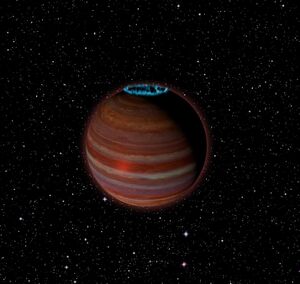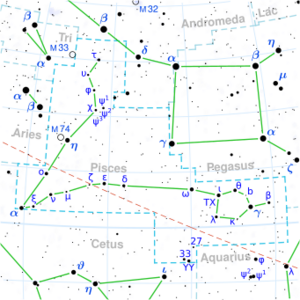Astronomy:SIMP J013656.5+093347
 Artist's impression of SIMP J013656.5+093347 and its auroras. Credit: Chuck Carter, Caltech, NRAO/AUI/NSF | |
| Observation data Equinox J2000.0]] (ICRS) | |
|---|---|
| Constellation | Pisces |
| Right ascension | 01h 36m 57s |
| Declination | +09° 33′ 47.3″ |
| Characteristics | |
| Spectral type | T2.5[1] |
| Apparent magnitude (J) | 13.455 ± 0.030 |
| Apparent magnitude (H) | 12.771 ± 0.032 |
| Apparent magnitude (K) | 12.562 ± 0.024 |
| Astrometry | |
| Proper motion (μ) | RA: 1238.982 ± 1.189[2] mas/yr Dec.: -17.353 ± 0.841[2] mas/yr |
| Parallax (π) | 163.4478 ± 0.4629[3] mas |
| Distance | 19.95 ± 0.06 ly (6.12 ± 0.02 pc) |
| Details | |
| Mass | 12.7 ± 1.0[4] MJup |
| Radius | 1.22 ± 0.01[4] RJup |
| Surface gravity (log g) | 4.31 ± 0.03[4] cgs |
| Temperature | 1098 ± 6[4] K |
| Rotation | 2.406 ± 0.008[5] hours |
| Age | 200 ± 50[4] Myr |
| Other designations | |
2MASS J01365662+0933473; IPMS J013656.57+093347.3; IBIS J013656.57+093347.3 | |
| Database references | |
| SIMBAD | data |
Location of SIMP0136 in the constellation Pisces | |
SIMP J013656.5+093347 (abbreviated SIMP0136) is a brown dwarf or planetary mass object[4] at 19.9 light-years from Earth in the constellation Pisces. It belongs to the spectral class T2.5[1] and its position shifts due to its proper motion annually by about 1.24 arcsec in the right ascension.[2]
This brown dwarf provided the first evidence for periodic variability flux variations among T dwarfs. This has been interpreted as a signature of weather patterns coming in and out of view over the object's 2.4h rotation period. The shape of this lightcurve evolves over timescales of days, which has been interpreted as a sign of evolution of the cloud patterns in its atmosphere.[5]
In 2017, it was announced that the object's mass may be as low as 12.7 Jupiter masses and might be considered a rogue planet rather than a brown dwarf as it seems to be a member of the relatively young, 200 million-year-old Carina-Near stellar moving group.[4][6][7]
In 2018, astronomers noted, "Detecting SIMP J01365663+0933473 with the VLA through its auroral radio emission, also means that we may have a new way of detecting exoplanets, including the elusive rogue ones not orbiting a parent star ... This particular object is exciting because studying its magnetic dynamo mechanisms can give us new insights on how the same type of mechanisms can operate in extrasolar planets - planets beyond our Solar System ... We think these mechanisms can work not only in brown dwarfs, but also in both gas giant and terrestrial planets."[7] During the observation with the VLA only one pulse was detected for SIMP0136.The magnetic flux of SIMP0136 was estimated to be 3.2 kG.[8]
References
- ↑ 1.0 1.1 Artigau (2009). "Photometric Variability of the T2.5 Brown Dwarf SIMP J013656.5+093347: Evidence for Evolving Weather Patterns". The Astrophysical Journal 701 (2): 1534–1539. doi:10.1088/0004-637X/701/2/1534. Bibcode: 2009ApJ...701.1534A.
- ↑ 2.0 2.1 2.2 Gaia Collaboration (2018-08-01). "Gaia Data Release 2 - Summary of the contents and survey properties" (in en). Astronomy & Astrophysics 616: A1. doi:10.1051/0004-6361/201833051. ISSN 0004-6361. Bibcode: 2018A&A...616A...1G.
- ↑ Brown, A. G. A. (2021). "Gaia Early Data Release 3: Summary of the contents and survey properties". Astronomy & Astrophysics 649: A1. doi:10.1051/0004-6361/202039657. Bibcode: 2021A&A...649A...1G. Gaia EDR3 record for this source at VizieR.
- ↑ 4.0 4.1 4.2 4.3 4.4 4.5 4.6 Gagné, Jonathan; Faherty, Jacqueline K.; Burgasser, Adam J.; Artigau, Étienne; Bouchard, Sandie; Albert, Loïc; Lafrenière, David; Doyon, René et al. (2017-05-15). "SIMP J013656.5+093347 is Likely a Planetary-Mass Object in the Carina-Near Moving Group". The Astrophysical Journal 841 (1): L1. doi:10.3847/2041-8213/aa70e2. ISSN 2041-8213. Bibcode: 2017ApJ...841L...1G.
- ↑ 5.0 5.1 Croll, Bryce; Muirhead, Philip S.; Lichtman, Jack; Han, Eunkyu; Dalba, Paul A.; Radigan, Jacqueline (September 2016). "Long-term, Multiwavelength Light Curves of Ultra-Cool Dwarfs: II. The evolving Light Curves of the T2.5 SIMP 0136 & the Uncorrelated Light Curves of the M9 TVLM 513". arXiv:1609.03587 [astro-ph.SR].
- ↑ "Presto change-o! Brown dwarf star is now a planet" (in en). 2017-05-11. http://newatlas.com/brown-dwarf-is-a-planet/49445/.
- ↑ 7.0 7.1 Starr, Michelle (3 August 2018). "There Is an Absolutely Gigantic Rogue Planet Wandering Our Galactic Neighbourhood". ScienceAlert.com. https://www.sciencealert.com/giant-rogue-exoplanet-simp-j01365663-0933473-magnetic-field-aurora-brown-dwarf.
- ↑ Kao, Melodie M.; Hallinan, Gregg; Pineda, J. Sebastian; Stevenson, David; Burgasser, Adam (August 2018). "The Strongest Magnetic Fields on the Coolest Brown Dwarfs" (in en). Astrophysical Journal Supplement Series 237 (2): 25. doi:10.3847/1538-4365/aac2d5. ISSN 0067-0049. Bibcode: 2018ApJS..237...25K.
Coordinates: ![]() 01h 36m 57s, +09° 33′ 47″
01h 36m 57s, +09° 33′ 47″
 |


